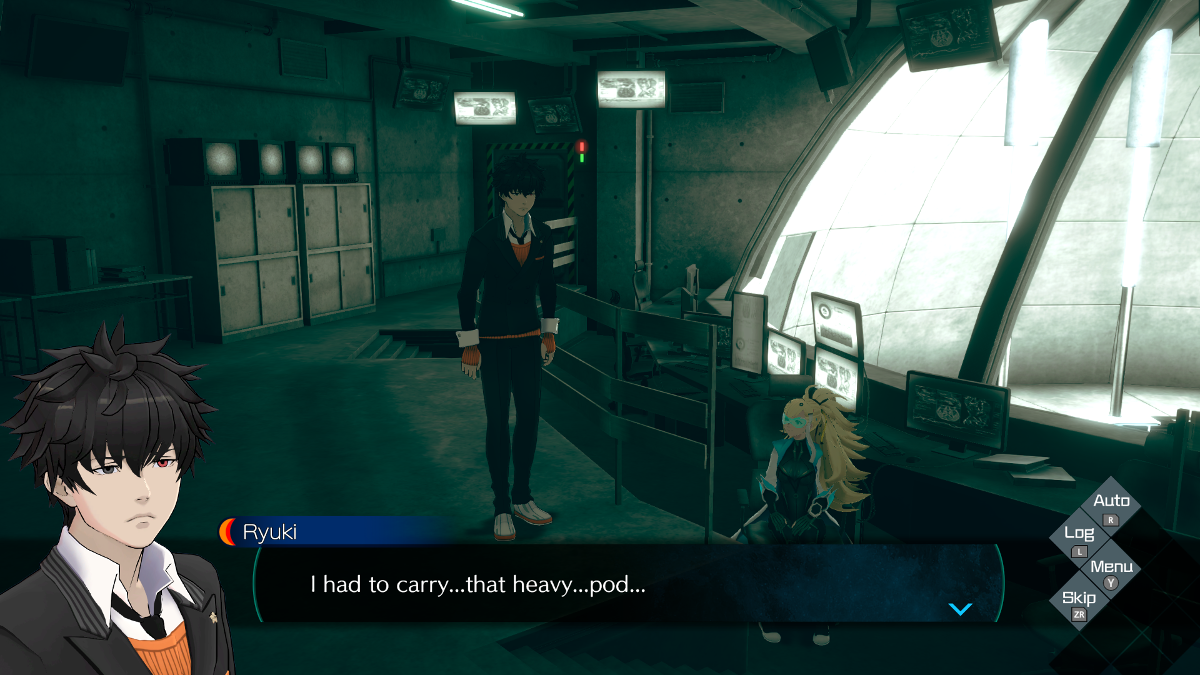
No Sleep For Kaname Date
by
Evan Norris
, posted 19 hours ago / 1,267 Views
Success is often about expectations. Expect too much and you could be underwhelmed. Expect too little and you may end up pleasantly surprised. Relevant to this conversation is the third entry in the AI series, No Sleep For Kaname Date – From AI: The Somnium Files. If you go in expecting something that matches the intensity and scope of the first game, you should, in the words of the Man in Black from Princess Bride, get used to disappointment. If, however, you accept it for what it is — a less ambitious spin-off with similar cerebral gameplay and a cast of characters you’ve come to love — you’re likely to have a good time.
No Sleep for Kaname Date takes place shortly after the dark events of AI: The Somnium Files. It follows detective Kaname Date, an agent of a secret branch of the Tokyo police called ABIS, an acronym for Advanced Brain Investigation Squad. Together with his partner Aiba, a snarky artificial intelligence embedded in his false left eye, Date investigates unusual, high-profile crimes — in this instance the disappearance of internet idol Iris Sagan.
Despite featuring many of the characters and locations from AI: The Somnium Files, No Sleep for Kaname Date does a remarkably good job shielding new players from the twists and turns in that game. You could complete this spin-off and then play the original without suffering from too many spoilers. That said, you should absolutely finish the first game before anything else. By doing so, you’ll eliminate even the smallest spoilers and familiarize yourself with the characters & themes in this latest adventure. More importantly, you’ll have played one of Kotaro Uchikoshi’s finest murder mysteries.
Uchikoshi returns in No Sleep for Kaname Date, but only as Scenario Supervisor. The Director and Scenario Writer this time around is Kazuya Yamada, who previously worked as a designer on AI: The Somnium Files and its sequel Nirvana Initiative. While Yamada can’t compete with Uchikoshi (who can, apart from Kazutaka Kodaka), he does improve upon the master in one area: comedy. This spin-off is far less sinister and mind-blowing than the original, but it has a cheekier sense of humor. I found myself laughing out loud more than once.
The comedic styling of No Sleep for Kaname Date is both a blessing and a drawback, though. This game is certainly more amusing than the mainline AI titles, but it’s also less consequential. Ultimately, it’s a side story, with lower stakes, fewer branching paths, and a shorter running time. It will take the average player around 15 hours to finish the campaign, where it would take roughly 30 hours to see each and every possible conclusion in The Somnium Files. To be fair, despite its relatively short running time, No Sleep for Kaname Date boasts several pieces of bite-sized post-game content, include visual novel vignettes and “deleted scenes” from the main campaign. It also, technically, has alternative endings, but they’re short and jokey.
Anyway, just because it’s inferior to one of the Uchikoshi’s best-written mysteries doesn’t mean it’s bad. Quite the opposite, in fact. This is a solid adventure game, one that imports many of the best things from earlier installments of the series: fantastical art direction, superior voice acting, sympathetic characters, heady sci-fi ideas, and an engaging gameplay loop that combines detective work in both the real world and a virtual space. Just as in The Somnium Files, you’ll investigate crime scenes and interrogate witnesses in Tokyo as Date, and search for clues and connections in the dream worlds of various suspects as Aiba.
These latter segments, which take place in the Somnium (or subconscious) of the suspect, are self-contained puzzle rooms that follow a sometimes counter-intuitive dreamlike logic. Using clues you’ve gathered in the real world and “key rules” discovered within the Somnium, plus your own creativity and intuition, you must break several “mental locks” preventing you from seeing the truth. And you must do so before 360 seconds expire. While these sections are more linear and less experimental than in previous games, they’re entertaining from both a puzzle-solving and narrative perspective. In fact, one of the most cathartic, emotional moments in the entire series takes place in one of these segments.
Somnium segments are not as prevalent as you might think, however, especially if you’re coming straight from The Somnium Files. In fact, they take a backseat to the newest addition to the series: escape rooms. It’s in this area where No Sleep for Kaname Date actually surpasses its predecessor, at least on the gameplay front. While Uchikoshi’s production is extraordinary in terms of storytelling, characterization, and unexpected, mind-melting twists, it does suffer a bit in terms of interactivity. Big pieces of that adventure are playable simply by selecting prompts or passively watching dialogue.
The introduction of escape rooms provides greater player agency and involvement. At several junctures in the game, characters other than Date must solve clues and manipulate objects to escape from an enclosed space with deadly fail states — all while under the watchful “third eye” of a mysterious reptilian host. These episodes are absolutely the highlight of the game. There are lots of tricky riddles and even a few genuine head-scratchers. And as the narrative moves forward, they get more complex. Toward the end, you’ll be responsible for managing three different escapees, in three separate rooms. The catch: clues from one room must be communicated to individuals in the other rooms. There’s a little Day of the Tentacle energy at work here.
Note: if you want to be challenged during these Escape sections, I strongly suggest adjusting the difficulty setting to hard. Even at normal, your colleagues produce too many hints.
Speaking of settings, if you play the game on Switch 2 you have a choice between performance and quality mode. Each mode is viable, and a clear visual upgrade from the Switch version of the game, thanks to less aliasing and superior resolution. Both modes target 60 fps but generally fall somewhat below that — in the 50-60 range. As a result, quality mode may be the superior offering; you’ll lose a few frames per second, yes, but get a cleaner, more stable image.
The Switch 2 version also arrives with support for mouse controls, although they’re implemented awkwardly. They allow you to use the right Joy-Con as a cursor, which is great in static first-person scenes, but inefficient in third-person exploration sections. The mouse deactivates the right stick, so you lose camera control. In order to reactivate it, you must hold the ZR trigger down and move the mouse in order to maneuver the camera. You’re better off skipping it.
No matter the mode or control scheme, you’ll experience the same art and assets. No Sleep for Kaname Date is one of those games that’s rather humble in terms of graphics, but obscures that fact through excellent production design. In other words, the game turns heads not through models, textures, and lighting, but through dreamlike landscapes, costumes, character designs, etc.
It also turns heads thanks to an amazingly talented roster of voice actors. The standouts include Greg Chun as Date, Erika Harlacher as Aiba, and Kaiji Tang as Moma. Music from series regular Keisuke Ito completes the audio equation. It’s quite good, although it leans too heavily on themes introduced in the premier AI title.
No Sleep for Kaname Date is a game all about setting the right expectations. If you anticipate another twisting, branching murder mystery from the brilliant mind of Kotaro Uchikoshi, you’re going to end up disappointed. If, however, you expect a less consequential, more comedic side story that places beloved characters in new, deadly escape room situations, you’ll emerge after 15 hours quite happy with your experience. In either event, make sure you play AI: The Somnium Files first.
VGChartz Verdict
This review is based on a digital copy of No Sleep For Kaname Date – From AI: The Somnium Files for the NS2, provided by the publisher.
Read more about our Review Methodology here
More Articles











